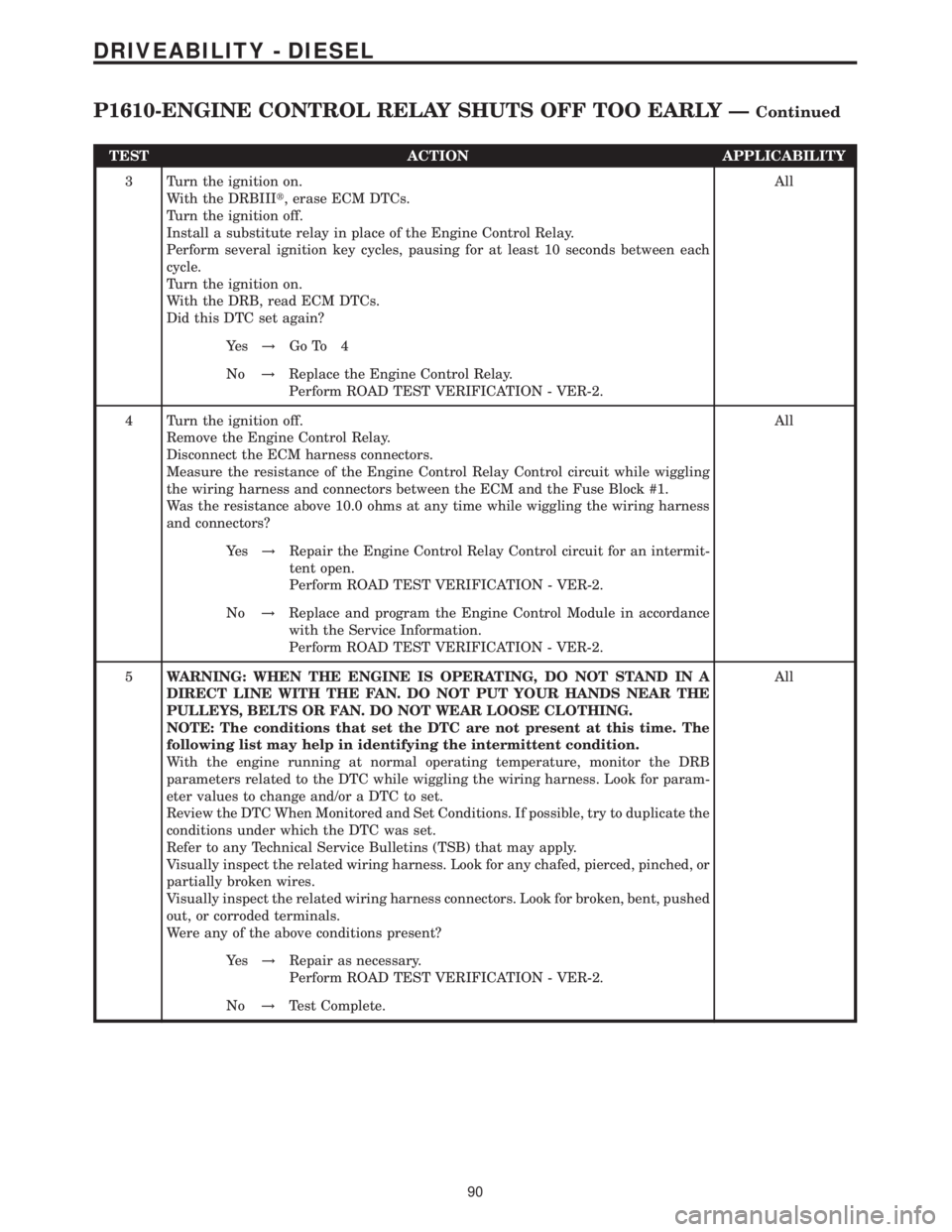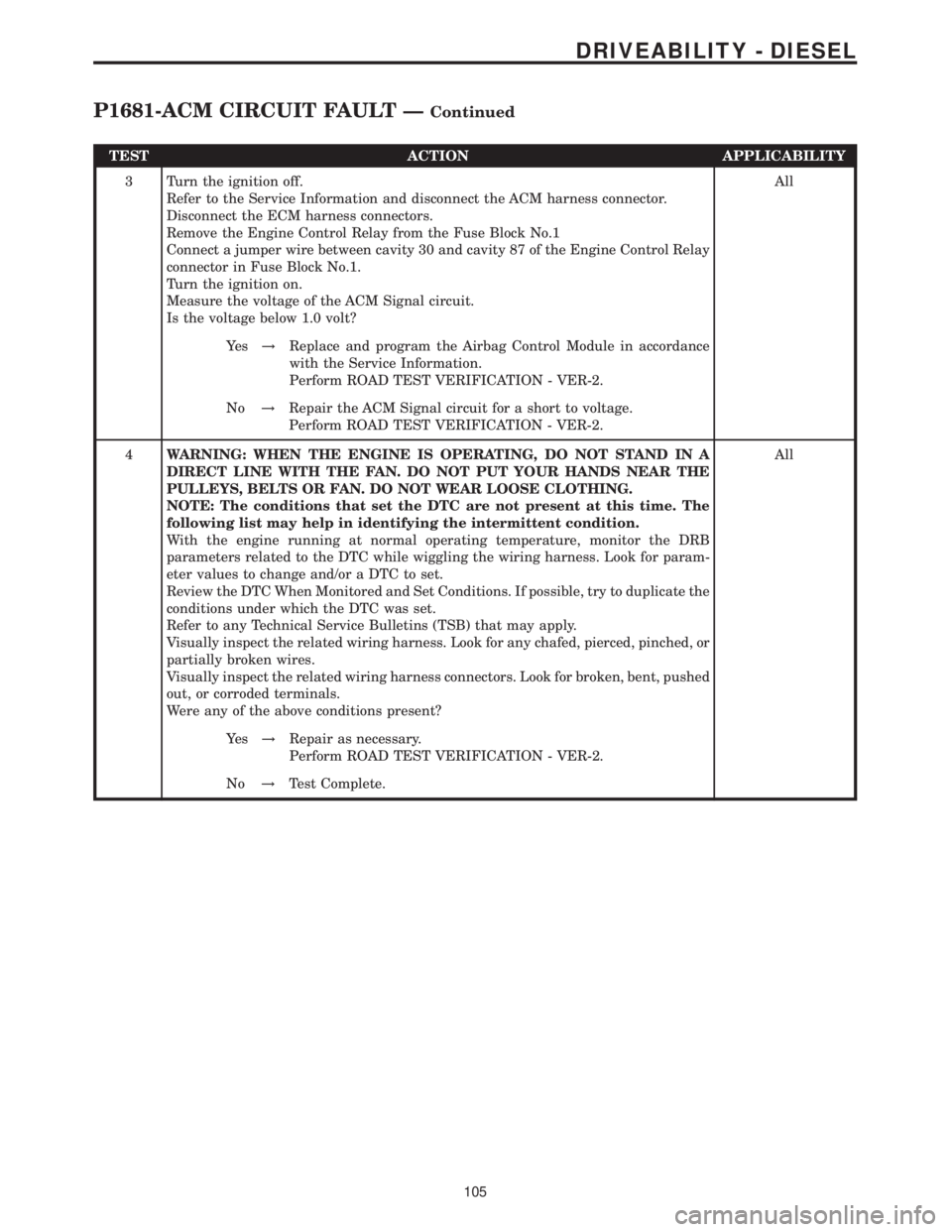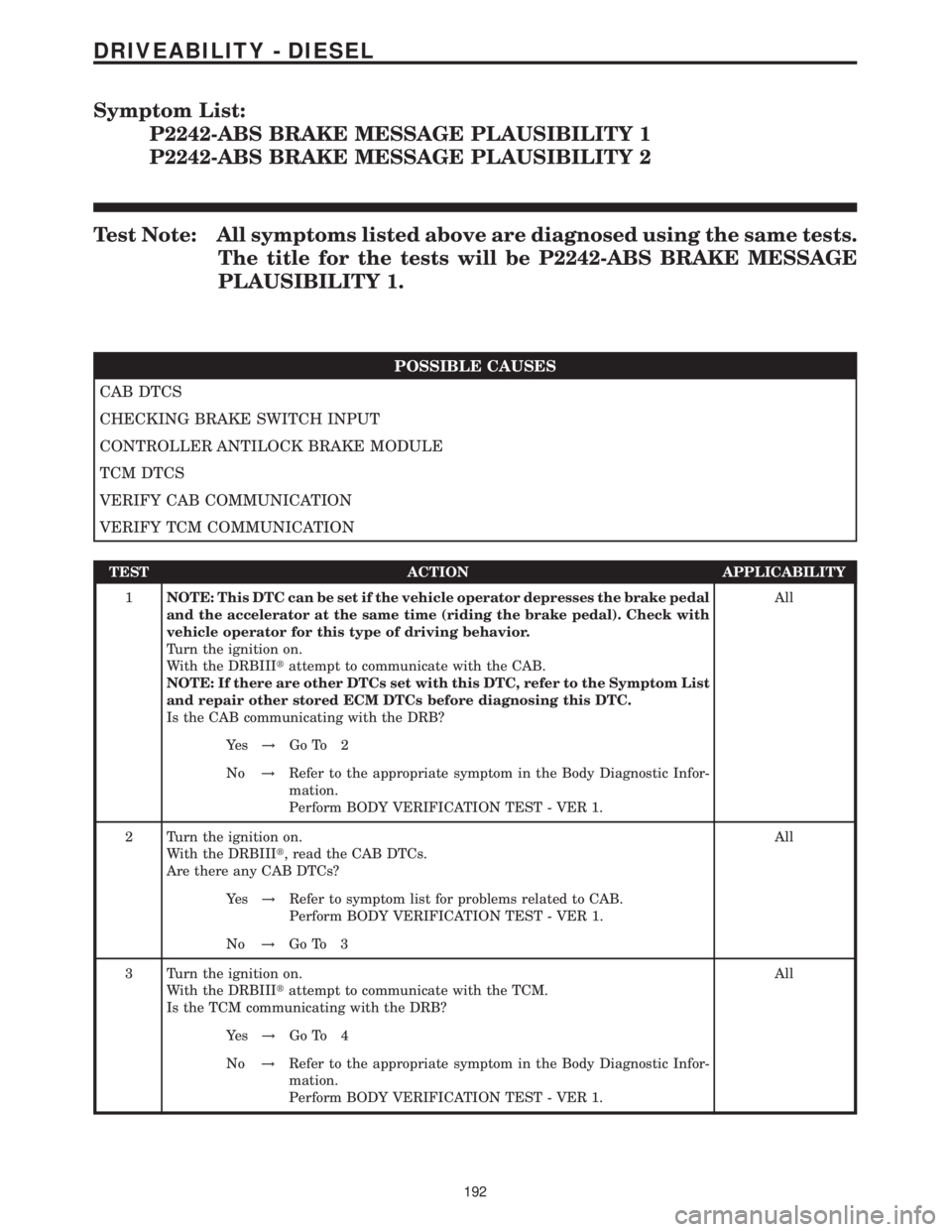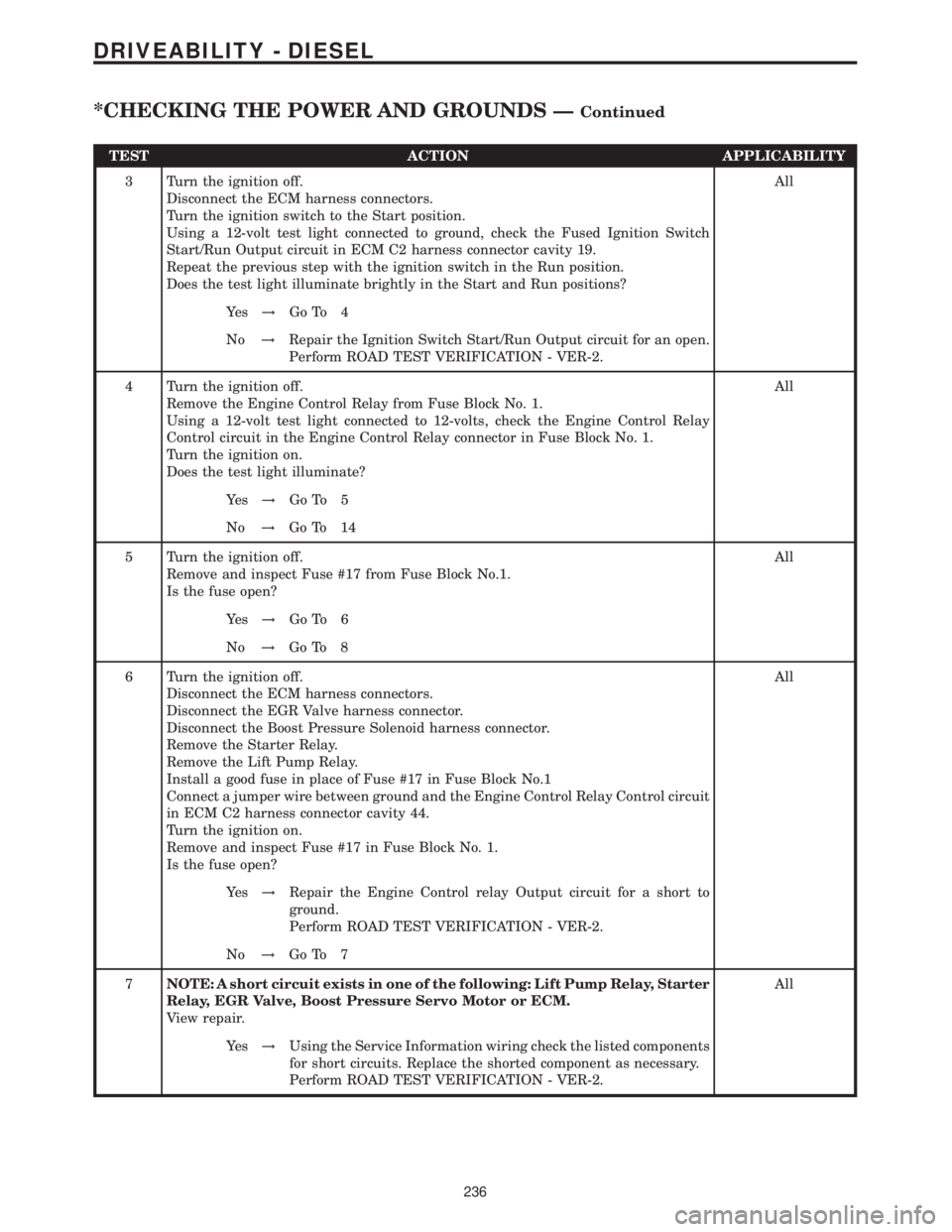2006 MERCEDES-BENZ SPRINTER lock
[x] Cancel search: lockPage 495 of 2305

TEST ACTION APPLICABILITY
3 Turn the ignition off to the lock position.
Disconnect the TCM C2 harness connector.
Disconnect the ECM harness connector.
NOTE: Check connectors - Clean/repair as necessary.
Measure the resistance of both the CAN C Bus (+) circuit and the CAN C Bus (-)
circuit between the TCM C2 harness connector and ECM harness connector.
Is the resistance below 10.0 ohms for each measurement?All
Ye s!Replace the Engine Control Module in accordance with the
Service Information.
Perform ROAD TEST VERIFICATION - VER-2.
No!Repair the CAN C Bus (+) and/or CAN C Bus (-) circuit for an
open.
Perform BODY VERIFICATION TEST - VER 1.
4WARNING: WHEN THE ENGINE IS OPERATING, DO NOT STAND IN A
DIRECT LINE WITH THE FAN. DO NOT PUT YOUR HANDS NEAR THE
PULLEYS, BELTS OR FAN. DO NOT WEAR LOOSE CLOTHING.
NOTE: The conditions that set the DTC are not present at this time. The
following list may help in identifying the intermittent condition.
With the engine running at normal operating temperature, monitor the DRB
parameters related to the DTC while wiggling the wiring harness. Look for param-
eter values to change and/or a DTC to set.
Review the DTC When Monitored and Set Conditions. If possible, try to duplicate the
conditions under which the DTC was set.
Refer to any Technical Service Bulletins (TSB) that may apply.
Visually inspect the related wiring harness. Look for any chafed, pierced, pinched, or
partially broken wires.
Visually inspect the related wiring harness connectors. Look for broken, bent, pushed
out, or corroded terminals.
Were any of the above conditions present?All
Ye s!Repair as necessary.
Perform BODY VERIFICATION TEST - VER 1.
No!Test Complete.
72
DRIVEABILITY - DIESEL
P0600-CAN DATA BUS - BUS CIRCUIT FAULT ÐContinued
Page 513 of 2305

TEST ACTION APPLICABILITY
3 Turn the ignition on.
With the DRBIIIt, erase ECM DTCs.
Turn the ignition off.
Install a substitute relay in place of the Engine Control Relay.
Perform several ignition key cycles, pausing for at least 10 seconds between each
cycle.
Turn the ignition on.
With the DRB, read ECM DTCs.
Did this DTC set again?All
Ye s!Go To 4
No!Replace the Engine Control Relay.
Perform ROAD TEST VERIFICATION - VER-2.
4 Turn the ignition off.
Remove the Engine Control Relay.
Disconnect the ECM harness connectors.
Measure the resistance of the Engine Control Relay Control circuit while wiggling
the wiring harness and connectors between the ECM and the Fuse Block #1.
Was the resistance above 10.0 ohms at any time while wiggling the wiring harness
and connectors?All
Ye s!Repair the Engine Control Relay Control circuit for an intermit-
tent open.
Perform ROAD TEST VERIFICATION - VER-2.
No!Replace and program the Engine Control Module in accordance
with the Service Information.
Perform ROAD TEST VERIFICATION - VER-2.
5WARNING: WHEN THE ENGINE IS OPERATING, DO NOT STAND IN A
DIRECT LINE WITH THE FAN. DO NOT PUT YOUR HANDS NEAR THE
PULLEYS, BELTS OR FAN. DO NOT WEAR LOOSE CLOTHING.
NOTE: The conditions that set the DTC are not present at this time. The
following list may help in identifying the intermittent condition.
With the engine running at normal operating temperature, monitor the DRB
parameters related to the DTC while wiggling the wiring harness. Look for param-
eter values to change and/or a DTC to set.
Review the DTC When Monitored and Set Conditions. If possible, try to duplicate the
conditions under which the DTC was set.
Refer to any Technical Service Bulletins (TSB) that may apply.
Visually inspect the related wiring harness. Look for any chafed, pierced, pinched, or
partially broken wires.
Visually inspect the related wiring harness connectors. Look for broken, bent, pushed
out, or corroded terminals.
Were any of the above conditions present?All
Ye s!Repair as necessary.
Perform ROAD TEST VERIFICATION - VER-2.
No!Test Complete.
90
DRIVEABILITY - DIESEL
P1610-ENGINE CONTROL RELAY SHUTS OFF TOO EARLY ÐContinued
Page 518 of 2305

TEST ACTION APPLICABILITY
3 Turn the ignition off.
Disconnect the APP and CMP Sensor harness connectors.
Disconnect the ECM harness connectors.
Remove the Engine Control Relay.
Connect a jumper wire between cavity 30 and cavity 87 of the Engine Control Relay
connector in Fuse Block No.1.
Turn the ignition on.
Measure the voltage at ECM harness connector cavities C1-38, C1-37, C2-13, C2-24
and C2-25.
Is the voltage above 1.0 volt for any of the measurements?All
Ye s!Repair the circuit(s) that measured above 1.0 volt for a short to
voltage.
Perform ROAD TEST VERIFICATION - VER-2.
No!Replace and program the Engine Control Module in accordance
with the Service Information.
Perform ROAD TEST VERIFICATION - VER-2.
4WARNING: WHEN THE ENGINE IS OPERATING, DO NOT STAND IN A
DIRECT LINE WITH THE FAN. DO NOT PUT YOUR HANDS NEAR THE
PULLEYS, BELTS OR FAN. DO NOT WEAR LOOSE CLOTHING.
NOTE: The conditions that set the DTC are not present at this time. The
following list may help in identifying the intermittent condition.
With the engine running at normal operating temperature, monitor the DRB
parameters related to the DTC while wiggling the wiring harness. Look for param-
eter values to change and/or a DTC to set.
Review the DTC When Monitored and Set Conditions. If possible, try to duplicate the
conditions under which the DTC was set.
Refer to any Technical Service Bulletins (TSB) that may apply.
Visually inspect the related wiring harness. Look for any chafed, pierced, pinched, or
partially broken wires.
Visually inspect the related wiring harness connectors. Look for broken, bent, pushed
out, or corroded terminals.
Were any of the above conditions present?All
Ye s!Repair as necessary.
Perform ROAD TEST VERIFICATION - VER-2.
No!Test Complete.
95
DRIVEABILITY - DIESEL
P1611-SENSOR SUPPLY 1 VOLTAGE IS TOO HIGH ÐContinued
Page 528 of 2305

TEST ACTION APPLICABILITY
3 Turn the ignition off.
Refer to the Service Information and disconnect the ACM harness connector.
Disconnect the ECM harness connectors.
Remove the Engine Control Relay from the Fuse Block No.1
Connect a jumper wire between cavity 30 and cavity 87 of the Engine Control Relay
connector in Fuse Block No.1.
Turn the ignition on.
Measure the voltage of the ACM Signal circuit.
Is the voltage below 1.0 volt?All
Ye s!Replace and program the Airbag Control Module in accordance
with the Service Information.
Perform ROAD TEST VERIFICATION - VER-2.
No!Repair the ACM Signal circuit for a short to voltage.
Perform ROAD TEST VERIFICATION - VER-2.
4WARNING: WHEN THE ENGINE IS OPERATING, DO NOT STAND IN A
DIRECT LINE WITH THE FAN. DO NOT PUT YOUR HANDS NEAR THE
PULLEYS, BELTS OR FAN. DO NOT WEAR LOOSE CLOTHING.
NOTE: The conditions that set the DTC are not present at this time. The
following list may help in identifying the intermittent condition.
With the engine running at normal operating temperature, monitor the DRB
parameters related to the DTC while wiggling the wiring harness. Look for param-
eter values to change and/or a DTC to set.
Review the DTC When Monitored and Set Conditions. If possible, try to duplicate the
conditions under which the DTC was set.
Refer to any Technical Service Bulletins (TSB) that may apply.
Visually inspect the related wiring harness. Look for any chafed, pierced, pinched, or
partially broken wires.
Visually inspect the related wiring harness connectors. Look for broken, bent, pushed
out, or corroded terminals.
Were any of the above conditions present?All
Ye s!Repair as necessary.
Perform ROAD TEST VERIFICATION - VER-2.
No!Test Complete.
105
DRIVEABILITY - DIESEL
P1681-ACM CIRCUIT FAULT ÐContinued
Page 615 of 2305

Symptom List:
P2242-ABS BRAKE MESSAGE PLAUSIBILITY 1
P2242-ABS BRAKE MESSAGE PLAUSIBILITY 2
Test Note: All symptoms listed above are diagnosed using the same tests.
The title for the tests will be P2242-ABS BRAKE MESSAGE
PLAUSIBILITY 1.
POSSIBLE CAUSES
CAB DTCS
CHECKING BRAKE SWITCH INPUT
CONTROLLER ANTILOCK BRAKE MODULE
TCM DTCS
VERIFY CAB COMMUNICATION
VERIFY TCM COMMUNICATION
TEST ACTION APPLICABILITY
1NOTE: This DTC can be set if the vehicle operator depresses the brake pedal
and the accelerator at the same time (riding the brake pedal). Check with
vehicle operator for this type of driving behavior.
Turn the ignition on.
With the DRBIIItattempt to communicate with the CAB.
NOTE: If there are other DTCs set with this DTC, refer to the Symptom List
and repair other stored ECM DTCs before diagnosing this DTC.
Is the CAB communicating with the DRB?All
Ye s!Go To 2
No!Refer to the appropriate symptom in the Body Diagnostic Infor-
mation.
Perform BODY VERIFICATION TEST - VER 1.
2 Turn the ignition on.
With the DRBIIIt, read the CAB DTCs.
Are there any CAB DTCs?All
Ye s!Refer to symptom list for problems related to CAB.
Perform BODY VERIFICATION TEST - VER 1.
No!Go To 3
3 Turn the ignition on.
With the DRBIIItattempt to communicate with the TCM.
Is the TCM communicating with the DRB?All
Ye s!Go To 4
No!Refer to the appropriate symptom in the Body Diagnostic Infor-
mation.
Perform BODY VERIFICATION TEST - VER 1.
192
DRIVEABILITY - DIESEL
Page 621 of 2305

Symptom:
P2306-SENSOR SUPPLY 2 VOLTAGE IS TOO HIGH
POSSIBLE CAUSES
BOOST PRESSURE SENSOR
FUEL PRESSURE SENSOR
VISUAL WIRING AND CONNECTOR INSPECTION
INTERMITTENT CONDITION
SENSOR SUPPLY VOLTAGE 2 SHORTED TO VOLTAGE
ENGINE CONTROL MODULE
TEST ACTION APPLICABILITY
1NOTE: If the ECM detects and stores a DTC, the ECM also stores the
engine/vehicle operating conditions under which the DTC was set. Some of
these conditions are displayed on the DRB at the same time the DTC is
displayed.
NOTE: Before erasing stored DTCs, record these conditions. Attempting to
duplicate these conditions may assist when checking for an active DTC.
Turn the ignition on.
With the DRB, erase ECM DTCs.
Turn the ignition off for 10 seconds.
Start the engine.
Monitor the DRB for ECM DTCs.
Did this DTC set again?All
Ye s!Go To 2
No!Go To 6
2 Turn the ignition off.
Visually inspect the wiring and connectors associated with the Boost Pressure Sensor
and Fuel Pressure Sensor for problems that may result in a short circuit.
Were any problems found?All
Ye s!Repair or replace wiring/connectors as necessary.
Perform ROAD TEST VERIFICATION - VER-2.
No!Go To 3
3 Turn the ignition off.
Disconnect the Boost Pressure Sensor and Fuel Pressure Sensor harness connectors.
Disconnect the ECM harness connectors.
Remove the Engine Control Relay.
Connect a jumper wire between cavity 30 and cavity 87 of the Engine Control Relay
connector in Fuse Block No.1.
Turn the ignition on.
Measure the voltage at all circuits in the Fuel Pressure Sensor and Boost Pressure
Sensor harness connector cavities.
Is the voltage above 1.0 volt for any of the measurements?All
Ye s!Repair the circuit(s) that measured above 1.0 volt for a short to
voltage.
Perform ROAD TEST VERIFICATION - VER-2.
No!Go To 4
198
DRIVEABILITY - DIESEL
Page 630 of 2305

TEST ACTION APPLICABILITY
3 Turn the ignition off.
Disconnect the Intake Air Pressure Sensor and Engine Oil Sensor harness connec-
tors.
Disconnect the ECM harness connectors.
Remove the Engine Control Relay.
Connect a jumper wire between cavity 30 and cavity 87 of the Engine Control Relay
connector in Fuse Block No.1.
Turn the ignition on.
Measure the voltage at all circuits in the Engine Oil Sensor and Intake Air Pressure
Sensor harness connector cavities.
Is the voltage above 1.0 volt for any of the measurements?All
Ye s!Repair the circuit(s) that measured above 1.0 volt for a short to
voltage.
Perform ROAD TEST VERIFICATION - VER-2.
No!Go To 4
4 Turn the ignition off.
Disconnect the Engine Oil Sensor harness connector.
Turn the ignition on.
With the DRBIIIt, erase ECM DTCs.
Turn the ignition off for 10 seconds. Turn the ignition on.
With the DRBIIIt, read ECM DTCs.
Does the DRB display this DTC?All
Ye s!Go To 5
No!Replace the Engine Oil Sensor.
Perform ROAD TEST VERIFICATION - VER-2.
5 Turn the ignition off.
Disconnect the Intake Air Pressure Sensor harness connector.
Turn the ignition on.
With the DRBIIIt, erase ECM DTCs.
Turn the ignition off for 10 seconds. Turn the ignition on.
With the DRBIIIt, read ECM DTCs.
Does the DRB display this DTC?All
Ye s!Replace and program the Engine Control Module in accordance
with the Service Information.
Perform ROAD TEST VERIFICATION - VER-2.
No!Replace the Intake Air Pressure Sensor.
Perform ROAD TEST VERIFICATION - VER-2.
207
DRIVEABILITY - DIESEL
P2332-SENSOR SUPPLY 3 VOLTAGE IS TOO HIGH ÐContinued
Page 659 of 2305

TEST ACTION APPLICABILITY
3 Turn the ignition off.
Disconnect the ECM harness connectors.
Turn the ignition switch to the Start position.
Using a 12-volt test light connected to ground, check the Fused Ignition Switch
Start/Run Output circuit in ECM C2 harness connector cavity 19.
Repeat the previous step with the ignition switch in the Run position.
Does the test light illuminate brightly in the Start and Run positions?All
Ye s!Go To 4
No!Repair the Ignition Switch Start/Run Output circuit for an open.
Perform ROAD TEST VERIFICATION - VER-2.
4 Turn the ignition off.
Remove the Engine Control Relay from Fuse Block No. 1.
Using a 12-volt test light connected to 12-volts, check the Engine Control Relay
Control circuit in the Engine Control Relay connector in Fuse Block No. 1.
Turn the ignition on.
Does the test light illuminate?All
Ye s!Go To 5
No!Go To 14
5 Turn the ignition off.
Remove and inspect Fuse #17 from Fuse Block No.1.
Is the fuse open?All
Ye s!Go To 6
No!Go To 8
6 Turn the ignition off.
Disconnect the ECM harness connectors.
Disconnect the EGR Valve harness connector.
Disconnect the Boost Pressure Solenoid harness connector.
Remove the Starter Relay.
Remove the Lift Pump Relay.
Install a good fuse in place of Fuse #17 in Fuse Block No.1
Connect a jumper wire between ground and the Engine Control Relay Control circuit
in ECM C2 harness connector cavity 44.
Turn the ignition on.
Remove and inspect Fuse #17 in Fuse Block No. 1.
Is the fuse open?All
Ye s!Repair the Engine Control relay Output circuit for a short to
ground.
Perform ROAD TEST VERIFICATION - VER-2.
No!Go To 7
7NOTE: A short circuit exists in one of the following: Lift Pump Relay, Starter
Relay, EGR Valve, Boost Pressure Servo Motor or ECM.
View repair.All
Ye s!Using the Service Information wiring check the listed components
for short circuits. Replace the shorted component as necessary.
Perform ROAD TEST VERIFICATION - VER-2.
236
DRIVEABILITY - DIESEL
*CHECKING THE POWER AND GROUNDS ÐContinued